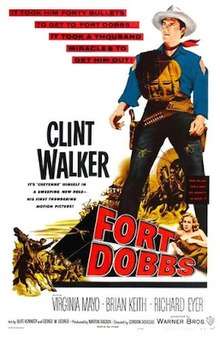Fort Dobbs
Fort Dobbs is a 1958 western, the first of three directed by Gordon Douglas to star Clint Walker. The other two were: Yellowstone Kelly in 1959 and Gold of the Seven Saints in 1961.[1]
| Fort Dobbs | |
|---|---|
 Theatrical release poster | |
| Directed by | Gordon Douglas |
| Produced by | Martin Rackin |
| Screenplay by | George W. George Burt Kennedy |
| Based on | the story "Backtrack" by George W. George Burt Kennedy |
| Starring | Clint Walker Virginia Mayo Brian Keith |
| Music by | Max Steiner |
| Cinematography | William H. Clothier |
| Edited by | Clarence Kolster |
Production company | Warner Bros. |
| Distributed by | Warner Bros. |
Release date |
|
Running time | 93 minutes |
| Country | United States |
| Language | English |
Based on a screenplay by George W. George and Burt Kennedy, with black-and-white photography provided by William H. Clothier, this 93-minute movie was released by Warner Brothers and was intended to capitalize on Walker's success in the Cheyenne TV series. Box office results, however, tended to be modest, thus reinforcing the notion that audiences were not likely to pay for at the theater what they could see at home for free.
Plot
Gar Davis has to get out of Largo in a hurry because a man's been killed. He comes across a man in Comanche territory killed by an arrow. Gar takes the man's jacket, then shoves the corpse over a cliff, hoping the posse pursuing him will think he's the one who is dead.
Trying to steal a horse, Gar's face is grazed by a bullet shot by young Chad Grey, whose mother Celia tends to the stranger's wound. Indians attack the house. Gar helps fend them off, after which he and the Greys take off on horseback toward the safety of Fort Dobbs.
On the trail, an outlaw called Clett kills a Comanche who's about to bushwhack Gar, saving his life. Gar doesn't trust him, though, because Clett is carrying cases of rifles that he could be selling to the Indians rather than to soldiers at the fort.
Clett tries to take advantage of Celia, but even though Gar comes to her aid, Celia no longer trusts him because she's found the jacket Gar stole. It belonged to her husband, so Celia is now convinced that Gar murdered him, making her a widow.
Fort Dobbs' soldiers are all dead. A sheriff appreciates Gar's help fighting the Indians, but lets him know he must place Gar under arrest. Gar claims he killed the Largo man in self-defense after an argument. Permitted to ride to Santa Fe to get help, Gar ends up killing Clett for the rifles, bringing them back to save the fort and to win the widow's trust.
Cast
- Clint Walker as Gar Davis
- Virginia Mayo as Celia Grey
- Brian Keith as Clett
- Richard Eyer as Chad Grey
- Russ Conway as the Sheriff
- Michael Dante as Billings
Production
Parts of the film were shot in Duck Creek, Aspen Mirror Lake, Paria, Kanab Canyon, Cave Lakes Canyon, Kanab movie fort, Colorado River, Mat Martin Wash, and Professor Valley in Utah.[2]
Reception
Critical response
Howard Thompson of The New York Times gave the film a mixed review, writing, "As for the plot, written by Burt Kennedy and George W. George, Mr. Walker plays a murder fugitive who rescues a widow and her small son from some Comanches and finally clears his name by leading a stockade defense against a mass attack. For the first two-thirds of this Martin Rackin production almost nothing happens, as the hero, Miss Mayo and young Richard Eyer drag across the prairie. The picture drags right along with it. Gordon Douglas, its director, has given the climax a neat turn or two. And toward the end, a couple of nice sideline performances click into place—namely, Brian Keith, as a renegade, and Russ Conway, as a sheriff. Miss Mayo also perks up considerably at the homestretch, minus her initial Southern accent. What happened, honey chile?"[3]
See also
References
- Fort Dobbs on IMDb
- D'Arc, James V. (2010). When Hollywood came to town: a history of moviemaking in Utah (1st ed.). Layton, Utah: Gibbs Smith. ISBN 9781423605874.
- Thompson, Howard. The New York Times, film review, "Western and 'Lafayette Escadrille' Open", April 19, 1958. Accessed: June 23, 2013.
External links
- Fort Dobbs on IMDb
- Fort Dobbs at AllMovie
- Fort Dobbs at the TCM Movie Database
- Fort Dobbs promotional spot on YouTube via TBS